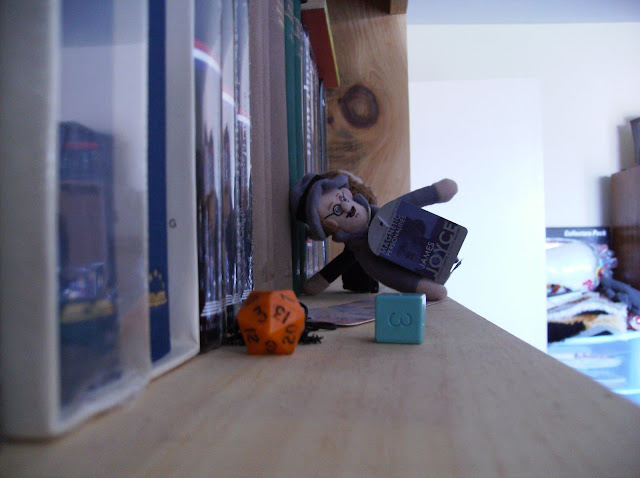BLOT: (13 Dec 2010 - 12:24:38 PM)
Take a look at my 27 year old dice...

On the left is an orange twenty-sided die. On the right, a blue six-sider. The orange one has black crayon marked letters, the blue should have white crayon but does not. These are from two of the box-sets from the 1983 revision of the "Basic" Dungeons & Dragons rules. In that year, the "Basic", as opposed to Advanced—aka Advanced Dungeons & Dragons, aka AD&D—which for fifteen or more years was the role-playing game, was released with a pared down rule-set which was neither the original, Chainmail-based rules from the first edition nor the increasingly more complex Advanced rules. Somewhere in between both.
Rather than give you the rules all in one place, it broke them down into five box sets, each not only expanding on a concept of the game but molded around a particular level range of characters. Each set had some player materials and some Dungeon Master material. The first box, which set up the basic rules and concepts of the game, was called, simply enough: Basic. It was for characters levelled 1-3, and was in a red box with red booklets and had orange dice with a black crayon. You got a simple set of six different color themed dice (4-, 6-, 8, 10-, 12-, and 20-sides) and the crayon was so you would color in the numbers yourself (the dice print, as seen in the above blue die, was all one color). I'm not sure if the later sets had any dice, which would be a shame, but at least the first two did: Expert's [level 4-14] was blue with white crayon, and another complete set of six dice.
TSR bounced around a few other versions of the "Basic" rules, culminating in a Rules Cyclopedia that I consider one of my favorite RPG products owned. However, the entrenched racism (all characters from a given character race are not only a given alignment, but have no variation in ability or class), summation of the "goodness" of all human action based on how much they follow law and order, and sometimes widely disproportionate levels of complexity from something like traveling the Planes (strangely simple) to building a castle (in which every little room can mapped out and micromanaged) make it a largely untenable game for more modern role-players. It shows its history as a game originally designed for miniatures and then left behind for a bigger, better flagship product. Still, for simple and old-school RPG fun, it is damn near unbeatable.
By the way, around the 1983 re-write and re-release of the "Basic" D&D, the AD&D line had three core rulebooks. Kind of thin things (maybe 90 pages?), they summed up all you needed to play in a Player's Handbook, a Dungeon Master's Guide, and the Monster Manual. I had two of them, but not the Dungeon Master's Guide, so was never able to play it. I did have the Deities & Demigods sourcebook, which had lots and lots of pantheons to add into your game. Lots. My god. Also, entries like Bast's had boobies showing, which was a revelation to an eight-year-old geek.
LABEL(s): Roleplaying Games.
BY WEEK: 2010, Week 50
BY MONTH: December 2010






